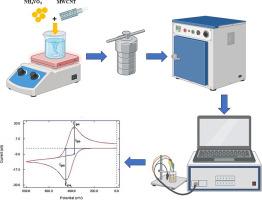Nanoplates of MWCNT_V2O5 nanocomposites using hydrothermal method for energy storage application
IF 5.1
3区 材料科学
Q2 MATERIALS SCIENCE, COATINGS & FILMS
引用次数: 0
Abstract
Vanadium Pentoxide (V2O5) is a versatile material for energy storage applications due to its appealing properties such as band gap and crystal structure. In this study, we used the hydrothermal technique to create Multi walled Carbon Nanotube (MWCNT) doped V2O5 nanomaterials. The doping of V2O5 synthesis uses multi-walled carbon nanotubes (MWCNT) ranging from 2 to 8 atomic percent. The concentration of vanadium source, reaction temperature, and reaction time were maintained at 0.14 M, 180 °C, and 6 h, respectively. A structural, morphological, elemental, and electrochemical examination was carried out, followed by 5 h of air ambient annealing at 500 °C. Comprehensive XRD analysis using multiple models (Scherrer, Monshi-Scherrer, Williamson–Hall UDM/USDM/UDEDM, Halder–Wagner, Wagner–Aqua, and Size–Strain) revealed that crystallite size decreased from 38.45 nm (0 at.%) to 34.97 nm (2 at.%) due to enhanced nucleation, then increased to 38.22 nm (8 at.%) owing to crystal growth and agglomeration. Microstrain showed an inverse trend, reaching a minimum of 2.85 × 10−3 at 4 at.% doping. TEM confirmed the orthorhombic structure with clear (200) lattice fringes (∼5.76 Å), and FESEM showed uniform nanoplate morphology (∼115 nm thickness) largely unaffected by doping level. FTIR spectra indicated preserved V₂O₅ bonding with evidence of interfacial interactions at higher MWCNT content. Electrochemical evaluation demonstrated that 8 at.% MWCNT doping yielded a fourfold increase in specific capacitance (259 → 607.14 F/g) and energy density (36 → 84.32 Wh/kg), along with a marked reduction in charge transfer resistance (R₁ from 26.48 Ω to 3.58 Ω; R₃ from 919 Ω to 1.85 Ω). The composite retained 87.74 % capacitance after 10,000 cycles, confirming excellent durability. These results highlight the role of optimal MWCNT incorporation (6–8 at.%) in enhancing microstructural features, electrical conductivity, and charge storage performance, establishing MWCNT–V₂O₅ nanocomposites as promising candidates for high-performance supercapacitor electrodes.

水热法制备MWCNT_V2O5纳米复合材料的纳米片用于储能
五氧化二钒(V2O5)由于其具有带隙和晶体结构等吸引人的特性而成为储能应用的通用材料。在这项研究中,我们使用水热技术制备了掺杂V2O5的多壁碳纳米管(MWCNT)纳米材料。V2O5的掺杂合成采用多壁碳纳米管(MWCNT),原子率在2 ~ 8之间。钒源浓度为0.14 M,反应温度为180℃,反应时间为6 h。进行了结构、形态、元素和电化学检查,然后在500℃下进行了5小时的空气环境退火。采用多种模型(Scherrer、Monshi-Scherrer、Williamson-Hall UDM/USDM/UDEDM、Halder-Wagner、Wagner-Aqua和size - strain)进行的综合XRD分析显示,晶体尺寸从38.45 nm(0℃)减小到38.45 nm(0℃)。%)至34.97 nm (2 at。%),增大到38.22 nm (8 at)。%)由于晶体生长和团聚。微应变呈相反趋势,在4 at时达到最小值2.85 × 10−3。%兴奋剂。透射电镜证实了具有清晰(200)晶格条纹(~ 5.76 Å)的正交结构,FESEM显示出均匀的纳米板形貌(~ 115 nm厚度),很大程度上不受掺杂水平的影响。FTIR光谱显示保存了V₂O₅键,并在较高的MWCNT含量下存在界面相互作用的证据。电化学评价表明8at。MWCNT掺杂使比电容(259→607.14 F/g)和能量密度(36→84.32 Wh/kg)增加了四倍,同时电荷转移电阻显著降低(R₁从26.48 Ω到3.58 Ω; R₃从919 Ω到1.85 Ω)。在10,000次循环后,复合材料保持了87.74%的电容,证实了优异的耐久性。这些结果突出了最佳MWCNT掺入的作用(6-8)。%)增强微观结构特征,导电性和电荷存储性能,建立MWCNT-V₂O₅纳米复合材料作为高性能超级电容器电极的有前途的候选者。
本文章由计算机程序翻译,如有差异,请以英文原文为准。
求助全文
约1分钟内获得全文
求助全文
来源期刊

Diamond and Related Materials
工程技术-材料科学:综合
CiteScore
6.00
自引率
14.60%
发文量
702
审稿时长
2.1 months
期刊介绍:
DRM is a leading international journal that publishes new fundamental and applied research on all forms of diamond, the integration of diamond with other advanced materials and development of technologies exploiting diamond. The synthesis, characterization and processing of single crystal diamond, polycrystalline films, nanodiamond powders and heterostructures with other advanced materials are encouraged topics for technical and review articles. In addition to diamond, the journal publishes manuscripts on the synthesis, characterization and application of other related materials including diamond-like carbons, carbon nanotubes, graphene, and boron and carbon nitrides. Articles are sought on the chemical functionalization of diamond and related materials as well as their use in electrochemistry, energy storage and conversion, chemical and biological sensing, imaging, thermal management, photonic and quantum applications, electron emission and electronic devices.
The International Conference on Diamond and Carbon Materials has evolved into the largest and most well attended forum in the field of diamond, providing a forum to showcase the latest results in the science and technology of diamond and other carbon materials such as carbon nanotubes, graphene, and diamond-like carbon. Run annually in association with Diamond and Related Materials the conference provides junior and established researchers the opportunity to exchange the latest results ranging from fundamental physical and chemical concepts to applied research focusing on the next generation carbon-based devices.
 求助内容:
求助内容: 应助结果提醒方式:
应助结果提醒方式:


